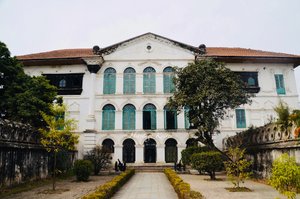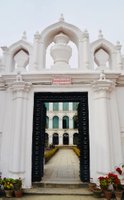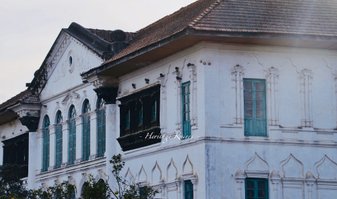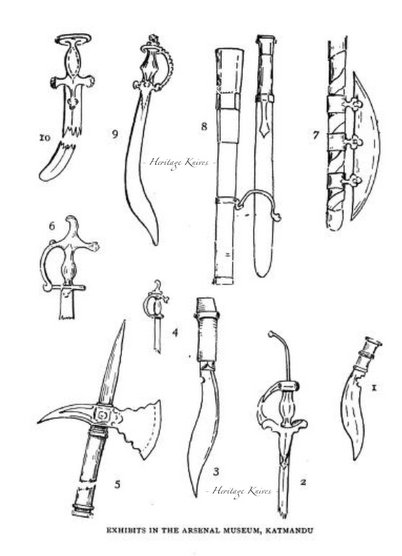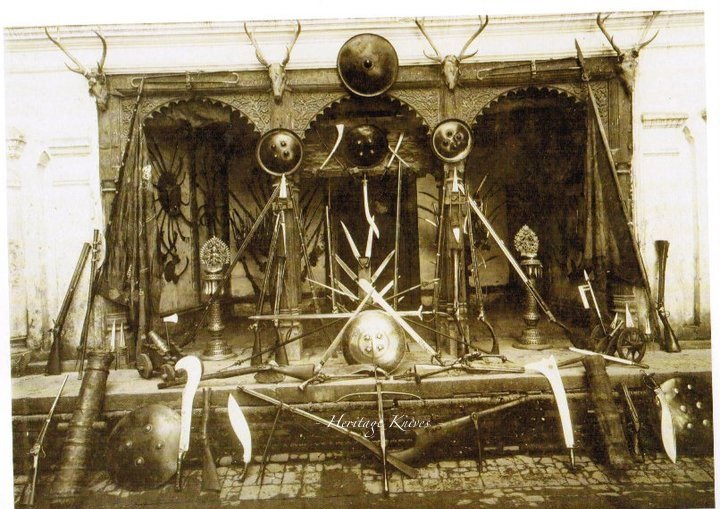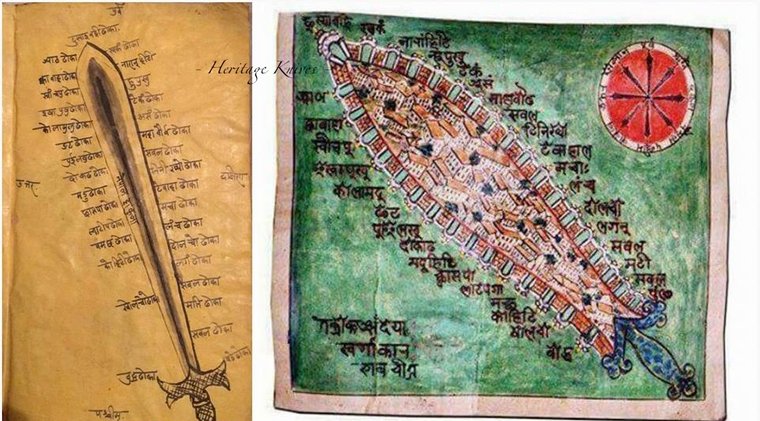KUKRI HISTORY & HERITAGE.
National Museum of Nepal, formerly the Arsenal Museum.
INTRODUCTORY NOTES.
INTRODUCTION -
This introduction is written as a reference to the Khukuri/Kukri knives from the mid 16th to early 20th century in the Arms & Armour gallery of the National Museum of Nepal. My intention here is that this text will serve the reader to understand what is shown in the Gallery better and grasp a better understanding of Nepalese history and heritage. While leaving many questions unanswered I intend to provide historical information on issues which is often overlooked in the “story” of the Khukuri, Nepal and the Gorkhalis by exploring this collection.
The Khukuri has its home in Nepal and made famous through being used by the Gorkhali military in the mid 18th and 19thcentury, followed by the Gurkhas/Gorkhas of the colonial British-Indian army in the 19th and 20th century. This knife has a long history in the hills of Nepal and material evidence at the National Museum shows early pieces from the mid 16thcentury onwards, among others that of King Dravya Shah, the founder of the Shah dynasty of Gorkha, which was to become the Royal House of Nepal in the second half of the 18th century.
The collection is one of the finest regarding Nepalese weapons from by gone times and gives a unique glimpse into the past and Nepal´s martial heritage. The gallery documents weapons and armour as used over several centuries mainly by the Gorkhalis. It was from these Gorkhali warriors that the latter developments which is popularly known as the Gurkhas of the British Army, Gorkhas of the Indian Army and the Nepalese Army came. Further in the text I will examine the meaning of “Gorkhali”, along with its development. The collection of the National Museum shows a great variety of Weapons which were locally made at various centuries, others imported and the influence neighbouring cultures and empires, such as the British, Chinese and “Indian” (Mughal).
I have paid attention to the broader historical context of the time they were used, the people and battles, to provide a framework for further understanding and research, instead of going into the details of each Khukuri. Further research is needed as the collection has never properly been studied earlier to my knowledge, there is no article, book or academic work regarding this collection published. The one work I am familiar with is Mr. Perceval Landon´s book “Nepal” (pub. 1928), Appendix 9, which has eight pages including four illustrations (1 full page and 3 half page) based on his short visit in 1924.
The following pages here is based on the Arms & Armour section as found at the National Museum which contains Khukuri/Kukri knives and span from the mid 16th century to the early 20th century (press on title to go to page below or use menu above):
Introduction.
18th - 19th century.
Battles of the Gorkhali (Nepalese) Military.
Early - mid 19th century.
Amar Singh Thapa (Sr.) - Bal Narsingh Kunwar-
Balbhadra Kunwar - Bhakti Thapa - Krishna Shah - Buddhibal Rana.
Text: Expansion & Decline.
Mid 16th - late 18th century.
Dravya Shah - Prithivi Narayan Shah -
Ranjit Malla - Sur Pratap Shah - Daljit Shah - Damodar Pande- Ram Krishna Kunwar.
Text: Rise of the House of Gorkha.
Early - late 19th century.
Bhimsen Thapa - Mathber Singh Thapa -
Jung Bahadur Rana - Bom Bahadur Rana - Fateh Jung Shah - Gambhir Singh Rayamajhi- Jagat Jung Rana - Jit Jung Rana.
2. The Expansion of the Gorkha Kingdom. Mid - late 18th century.
Amar Singh Thapa (Jr.) - Abhiman Singh Basnet - Ranjit Kunwar - Nain Singh Thapa.
Text: The Gorkhali Military.
5. The Shumsher Brothers Dynasty.
Late 19th - early 20th century.
Bir SJB Rana - Dev SJB Rana -
Chandra SJB Rana.
Text: End Notes - Duty of History & Museums.
The collection of Arms & Armour is the material evidence of Nepal´s martial heritage and a past which formed the base of the country´s development into a modern nation- state. In any discourse about the making of Nepal, the conquest of the Kathmandu valley is a central topic and here at the National Museum we find some of the weapons used in making Nepal. The collection is divided along various officers (and kings) who played a important role in the making of Nepal and safeguarding the country through battles and/or policies. Several known characters of Nepal´s history are left out most likely due to their weapons not being at the Museum´s collection. This does not make the collection of any less value though as there is plenty of examples covering the period of making Nepal a country.
I have limited the photos in the following pages to those which contain Khukuri knives, which is the majority of the collection and gives a good overview of what can be seen upon visiting the Museum. Sadly the Arms and Armour gallery has only given names and dates of the person these weapons belonged to and nothing further, overlooking the context these weapons were used in and the persons whom they are attributed too. To counter this issue I have here provided links to Wikipedia and other sites to explain the various battles and with each person a short introduction to them. An image may say a thousand words but placed out of context it does not justify its importance.
Arms and armour is an important part of a cultures heritage and provides important facts, ideas and clues as to the past. A pas that belongs to us and not to a group specifically, specially as the Gorkhalis were not an ethnic group but was multi-ethnic in its composition, from the lowest strata to the highest as per Hindu tradition. Nor were all Gorkhalis Hindus but included followers of Buddhism, Shamanist/Animism and a small group of Muslims too working under the Hindu system of the Shah rulers.
The study of weapons and armour is not only about how the warrior preserved himself in battle and warfare but represents a strong cultural symbol of the time it was made and used, it relates to technological development, (international) trade, cross cultural influences, contemporary ideas and beliefs and dwells into both the arts and sciences. It could be summarized as a method to get to know the historical past of mankind and here specifically that of Nepal.
The record of many great warriors and souls lost and ignored, both intentionally and unintentionally due to not maintaining history in a way useful for later researchers as well as the general lack of interest in history. In one hand I praise the Gorkhalis for creating Nepal while the other hand question the way it was done, where by several socio-ethnic groups had their heritage systematically supressed and erased by those in power. Following the Gorkhali “unification” of Nepal came a period of Sanskritisation whereby various “native” groups were sidelined, their heritage supressed and history partly erased. Unlike most of South Asia, Nepal was never colonized by a foreign power but went through its own Karma, in some ways similar to the colonies and in many ways different. Instead of a foreign colonial master, the master in Nepal was one of its own groups.
Image from Landon´s book "Nepal" from the mid 1920´s based on his visit to the Museum.
1. "Another treasure of the Museum is the same king´s (Prithwi Narayan Shah) kukhri, which has overlapping waves of steel upon the blade, apparently intended to add to the weight of it."
2. "...the sword of Damodar Panre (Pande). Impressive as this is with its 4 feet 9,5 inches of blade and 10,5 inches hilt, it can scarcely have been effectiveas a less pretentious weapon."
3. "This has a blade 10,5 inches in length, and an ivory handle a shade under 5 inches."
4. "One sword is 33, 7/8 inches in length and 1 inch in width."
5. "The 5 foot sword of Prithwi Narayan (Shah) is also shown in the same room, together with a most curious halberd."
6. "The other blade is 34, 1/8 inches in length and 1 inch in width. The beuaty of the handles will be noted." (ref. No. 4 & 6)
7. "...the heading-axe that was used in Kathmandu until a comparatively late date. This is a weapon of great weight and strength."
8. "...a sword of leaf shape with an ivory handle set round an octagonal steel mount. There is nothing in the sword itself to excite much interest, but the scabbard, which is ser beside it, possesses an extraordinary appendage which may be best seen in the accompanying illustration. "
9. "...there are in the Arsenal two intressting relics in the shape of a forward-bending sword-it can hardly be called a kukhri-of which the blade is 25 inches in length. The handle is of elaborately wrought steel."
THE NATIONAL MUSEUM OF NEPAL (formerly THE ARSENAL MUSEUM).
“Where else in the world can you see some of the most important religious stone sculptures of the land, a room full of “breathtaking bronzes”, a collection of priceless Paubha scroll paintings, a world class collection of ancient Asian firearms, swords and khukuris, and several leather cannons captured during the 1788 war between Nepal and Tibet? Nepal’s National Museum at the Chhauni has all this, and more.”
The pages based on the National Museum of Nepal is in conjunction with our page on Military History. We therefore recommend the reader to access both pages and they supplement each others and give a firm base for further understanding. The pages dealing with the National Museumof Nepal, besides this introduction are:
1. The Making of Nepal (mid 16th to 18th century).
2. The Kingdom of Gorkha (18th century).
3. The Anglo-Gorkha War (19th century).
4. The Thapa & Rana Era (19th century).
5. The Shumsher Rana Era (19th to 20th century).
The National Museum of Nepal has played a important role for me, I grew up close to it as a child, my grandfather served in the military barracks next door and over the years with my interesst in the martial traditions of the Himalayas I`ve spend innumberable hours there. From the 1990´s onward I`ve been able to photograph the collection well and by doing so to document it over the last 25 ish years.
Established prior to 1928 in a building from the first half of the 19th century built by Prime Minister Bhimsen Thapa.
Originally built as the new Army HQ under Bhimsen Thapa who employed French assitance to build it along with the gun foundry at Swayambhu and the arsenal in Balaju.
A early photograph of the old Kot "Arsenal" in Kathmandu, ca. 1860-1890. Many of these weapons were transfered to the building the National Museum is today housed in, probably during Chandra SJB Ranas time.
In 1923-24 Mr. Perceval Landon visited the Museum, then called the Arsenal Museum (Chhauni Silkhana (Chhauni Arsenal)), which is mentioned in his book “Nepal” (pub. 1928). Mr. Landon´s book is a important work as one of the only sources of information on the Museum and its collection. He lists several weapons in the collection, of which nine he has drawn (see image to the right) and explained.
Initially the Museum was only open for guests invited by the Prime Minister Maharaja. A large military barrack is located to the Museums northern and eastern side, along with the more recent Military museum just opposite. The Military Museum along with more recently opened museums in Nepal have taken part of the collection from the National Museum, which as most museums also has a large amount in storage.
The Museum was opened to the public in 1939 by PM Maharaja Juddha SJB Rana who also added a new section, Juddha Jatiya Kalashala, the art museum section. In 1967 the premesis was renamed to Rashtriya Sangrahalaya ("National Museum of Nepal") by King Mahendra of Nepal.Three buildings form the Museum complex: Juddha Jayatia Khate Sala, Buddha Art Gallery and the main (old) building which consists of Natural History, Arms & Armour, Cultural and Philatelic sections.
It is the largest Museum in Nepal and plays an important role in showcasing the cultural and historical heritage of Nepal. Among the main attractions are collections of religious artworks (sculpture and paintings) dating back to the 2nd century AD and a display of historic weapons used in the wars in the 18-19th century. This includes captured weapons and foreign gifts, including Swords given by Napoleon III of France to Prime Minister Jung Bahadur Rana in 1850-51 while visiting France and guns he bought in London (see 4. The Thapa & Rana Era).
Following the earthquake of 2015 the Arms & Armour section was under renovtion and in 2019 opened its doors again.
A old map of Kathmandu (Kantipur) from the late Malla period. As you can see the city is designed as a traditional sword and reflects a strong martial heritage of the various Himalayan groups that makes up the Nepalese.
Military Titles:
Jetha buda – a temporary or complimentary title of a recognised career in military, a senior advisor on military matters including some on State function. Often a Royal messenger as would have been a well established and known figure to deliver messages and orders from the King.
Senadhipati - Commander in Chief. The overall commander was the King, known properly as "Pradhan senadhipati", while Senadhipati was given to one or several leading commanders close to the King. A Chautaria/Mukhtiyar or Kaji could at times share some of these duties and Senadhipati was a title more common for a military campaign then at times of peace. Replaced in the mid 19th with Commander-in-Chief.
Sardar – General / Senior military commander, whom may have had duties in newly conquered areas as a Governor. The Sardar led major military expeditions, commanded forts or administered newly conquered territory. Similar as the Mughal administrations “Bashis”. From the mid 19th century, from Jang Bahadurs time the Sardar was a civil functionary appointed as the head of a govt. department or district governor.
In the military earlier Ranks and Titles were replaced with English or Urdu/Persian at par with the Indian Army to a large degree.
Nepalese Civil/State and Military titles:
Maharajadhiraj - King of Kings, a King that had subdued other areas and assumed thier power, ruler of a larger area. A title of honour and high power. In Nepals case there were smaller rulers whom incorporated their areas into the Gorkha Kingdom, which became Nepal, for example: Mustang, Jajarkot, Salyan & Bajhang, mainted thier own royal houses and ranked below the Maharajadhiraj, as Maharaja or Raja.
Maharaja - Great king, a ruler of several areas but not as large as the domains or power of the Maharajdhiraj. Several Maharajas and Rajas could exist under the Maharajdhiraj. From Jung Bahadur Ranas time, his family were given the title of Maharajas of Kaski & Lamjung.
Raja - King, the ruler of one region/area for example Manang or Bajhang. The Shah dynasty took the title Maharajadhiraja after the conquest of Kathmandu, priorly holding the title of Raja of Gorkha.
Chautariya – similar to post of Prime Minister (internal affairs) in the 18th and early 19th century, usually a member of the royal family, i.e Kings brother or close relative. 3rd highest office in the State Administration (1. King, 2. Crown Prince).
In the late 18th century expanded to two Chautariyas as the Kingdom and Royal family grew.
The post was replaced with the office of Mukhtiyar in the early 19th century who had the responcibility as chief administrator. The office of Chautaria continued for a large part of the 19th century but without a clear role. Bhimsen Thapa made the office of Chautaria into a ceremonial role, taking that power himself and given more as a title then responcibility.
Mukhtiyar - replaced the Mul Kaji in 1806 by King Rana Bahadur. The Mukhtiyar carried executive powers of nation to completely control Nepalese administration. It would be suitable to call it for a early form of Prime Minister. Mathber Singh Thapa in the 1840´s was the first person in Nepal to use the title of Prime Minister. The Office of Prime Minster in Nepal awas firmly adapted by the Rana dynasty, whom made it hereditary within their own family.
The Mukhtiyar was often also the C-in-C and headed the Civil Administration of the country.
Kaji / Kazi – in Nepal´s context used as a rank/title by appointment can be said to meant a Minister of the King.
The origin of the word is probably from Persian meaning "Civil Judge", or from the Sanskrit word "Karyi" meaning "Functionary"
The duties of the "Kaji" were similar to the Mughal administrations "Dewan", performing both military and civil functions. The Kaji was a supervisor of civil and military affairs, commanded army units, oversaw revenue and tax matters and served the King to run the State. At times the Kaji was also the States main person over an area/district, similar to a Governor. The Kaji ranked immediately under the Chautariya.
The number of Kajis grew as the Kingdom expanded. In the early 1800´s, Dr. Francis Buchanan-Hamilton wrote in his work "An Account of the Kingdom of Nepal" (1819) that there was four Kajis. During Bhimsen Thapa´s reign from around 1810-1830´s the number of Kaji´s grew as Nepals borders had never been larger, and the State apparatus became more complex.
Among the Kaji´s there was one "Mul Kaji", Cheif Minister and has at times wrongly been called Prime Minister. In the early Gorkha Kingdoms expansion, until the Anglo-Gorkha War there was also a "Bada Kaji", whom served as a the head of civil and military affairs of a newer large territory and may have replaced the Mul Kaji or served along side. "Bada" meaning Big/Senior. It has also come to light that not only "Bada" but also "Buda" has been used, meaning "Older/Senior". Thus the term should be Bada Kaji or Buda Kaji. After the conquest of the Kathmandu Valley in 1769 it was made a standard practise that one of the Kaji´s were a Newar (partly to appease the local population) and a Gurung or Magar (both groups formed the majority of the military men and had since the early days of King Prithvi Narayan Shah served as a principal group in the Gorkha Kings military.) The majority of the Kaji´s came from Chettri families whom hd a long history of service to the House of Gorkha and proven their loyalty as Commanders in the military.
Vakil – a diplomatic envoy or representative.
Copyright © 2020-2023 Heritage Knives, by Kila Tool Works (P) Ltd. All rights reserved.
No part of this publication may be reproduced, distributed, or transmitted in any form or by any means, including photocopying, recording, or other electronic or mechanical methods, without the prior written permission of the author/web publisher, except in the case of brief quotations embodied in critical reviews and certain other noncommercial uses permitted by copyright law. For permission requests, write to the web publisher.
